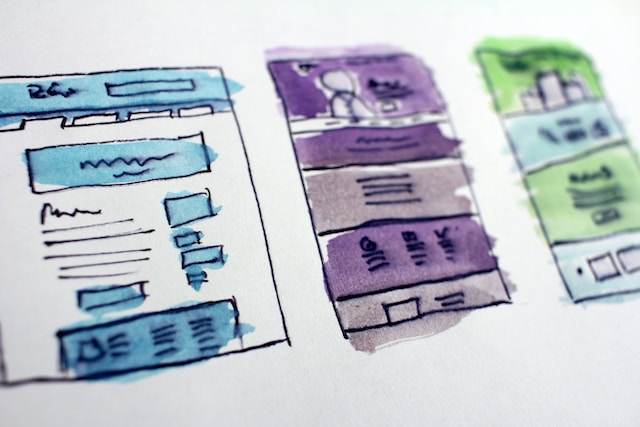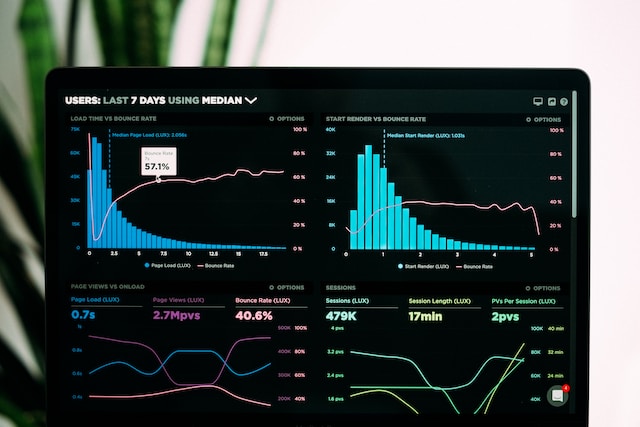For any UX designer, making digital products that are accessible, useable, and enjoyable is essential, especially concerning their users’ experiences. Positive user and customer experiences help to establish a long-lasting relationship between a brand and its customer base.
You could optimize the experience of your existing customer base or refine your product to attract new users. In either instance, your design process could lead you to multiple ‘correct’ solutions. The challenge is knowing which design solution will evoke the best user experience when all solutions seem optimal.
This is where A/B testing comes in. You may ask, ‘What is A/B testing?’. If A/B testing is something you’re unsure about, don’t worry — you’ve come to the right place.
Within today’s guide, we shall answer your question. We shall also address the components integral to A/B tests and their variants. By the time you’ve finished reading this article, you will be an expert!

So, What Is A/B Testing?
A/B testing is a quantitative research method whereby you measure the performance of your product by testing its variations. A/B testing determines which of the two variations of your digital products is more profitable.
During the marketing period of an upcoming product, it’s likely that your business goals will fluctuate. Consequently, your product’s design process may require refinements.
A/B testing reveals the best design decisions when implementing modifications. Through A/B tests, you can compare user satisfaction, conversion rates, or the overall interaction between users and your products.

What Is A/B Testing in Marketing?
A/B testing in marketing remains largely unchanged; however, there are some slight distinctions. With that being said, you’re likely to ask the question, ‘What is A/B testing in marketing?’
As in UX research, an A/B test in marketing involves the creation of two variations of a digital asset.
You can measure the performance of each variation based on conversion goals. Percentages often represent conversion goals via click-through rates, the completion of forms, and purchases made on a site.
In marketing, A/B testing is an incredibly beneficial conversion optimization strategy that will help a business flourish.
Additionally, in marketing, you would typically use A/B testing to test many aspects of a marketing campaign. This means that the usual test subjects would consist of emails, newsletters, ads, landing pages, or mediums already in use.
When Should You Conduct an A/B Test?
Simply put, you should use A/B tests at every stage of the design process. Your mission is to refine your users’ experiences. Ergo, it would be ideal to conduct several A/B tests for different variables.
However, this isn’t always realistic. Although A/B tests produce valuable data, testing every one of your product’s elements would be time-consuming. Considering the pressing duties of a UX designer, dedicating most of your time to A/B testing would be unwise.
We recommend an alternative solution. You should employ A/B testing when you wish to remove/update vital product features that would alter its description.
Additionally, it would be appropriate to prioritize which features you wish to test. Carefully consider which of your product’s features will have the greatest impact on your users’ experiences.

What Can You A/B Test?
With that being said, you may still feel unsure about which features you should prioritize.
We’ve assembled a list of the most common product features to analyze so that you can start optimizing your product!
1. Headlines/Titles
Headlines – and subheadlines, for that matter – serve as the first impression a user has with your site/product.
Headlines also summarize what type of content your users expect to find on your site. Due to this fact, it’s imperative that your headlines don’t convey confusing messages that will leave your users feeling lost.
Being the first piece of content that your users absorb, you must be cautious. Ensure your headlines are concise, summarize the main point of the screen, and engage the user. Your headlines must also communicate both the desired action and the value of completing the desired action.
Therefore, you could conduct A/B tests on different fonts/writing styles that test the enjoyability of your headlines. In evaluating the users’ engagement, you can identify what motivates them to use your product/site.
2. The Primary Textual Content
Your primary textual content addresses what your users can expect to receive from interacting with your product. Your textual content should expand and relay the message that your headline conveys.
Your copy should actively answer the user’s question, revealing if your product can help them solve their problems. This copy is brief, so employ lexical choices that increase usability and use stylistic elements that emphasize important information.
However, that doesn’t mean you can’t incorporate your creative flair.
To optimize your primary textual content, you should experiment with format, writing style, and tonality.
For instance, you could conduct A/B tests on tone of voice. By comparing familial, humorous, and strictly informative tones, you can see which approach resonates more with your users.
3. Content
The quality of your content will determine if your product solves the users’ issues and exceeds their expectations.
So, with that in mind, you must ensure that your content doesn’t come with a substantial learning curve. In having a smaller learning curve, you will maximize the user’s engagement. Maintaining your users’ attention is crucial – if your users become frustrated and abandon your content, your product will be ineffective.
For instance, a good way to test your users’ engagement/attention span is to create two versions of the copy. Make one copy detailed and lengthy, and make the other ideal for those who usually skim through content.
After the testing has finished, you’ll be able to analyze what type of content engages the user the most.
4. Design
Implementing visual elements is a vital facet of any product. Not every user will absorb content through copy, and it’s important to accommodate those users’ needs.
You now face a decision regarding which visual elements will convey your product’s content effectively.
You can employ A/B testing to evaluate your use of icons, images, videos, animations, and so on.
While you’re looking to see which elements engage the users, you must utilize visual elements that answer your users’ questions.
5. Navigation
Navigational ease has a considerable influence over the enjoyability of your digital experiences.
Navigational fluidity often starts at the home page, but this isn’t always the case. It’s imperative that you remember that your users can encounter your product for the first time through another web page.
Every user should be able to use their intuition to find their desired page.
With A/B testing, you can test your product’s composition to see if it meets your users’ expectations. You don’t have to use conventional navigational aids. By providing an atypical layout, you can increase your product’s uniqueness and demonstrate your creativity as a UX designer.
However, by reinventing the wheel, you risk your users no longer knowing how to use it.
An A/B test can reveal how conventional/creative your product’s navigational elements can be before the user becomes lost.
6. CTA
Your CTA (Call To Action) is an essential part of your service. This is the part where your users complete a desired action, whether that is completing a purchase or signing up.
Essentially, your CTA has a direct, significant impact on your conversion rates.
With A/B testing, you can test variations of your CTA. Experiment with placement, visual design, user flows, and so on. You can then determine which variant of your CTA generates a higher conversation rate.
7. Additional Elements To Analyze
Needless to say, the list above isn’t exhaustive. It’s worth noting that you should also consider conducting A/B tests for the following:
- Forms.
- Emails.
- Facebook ads.
- Social media posts.

Types of A/B Tests
Needless to say, knowing when and what to test is one thing. However, in order to acquire the most useful data, you must know what type of A/B test to conduct.
Split Testing
With split testing, you test a new version of an existing web page to evaluate which variant performs better.
When should you utilize split tests? When you wish to evaluate the entire design/copy of your product’s pages without making permanent changes.
Split testing is perfect for the innovative UX designer who wishes to test new designs on dynamic content. In addition, split tests offer valuable insights into how you should adapt web page workflows.
Multivariate Testing
Multivariate testing refers to the simultaneous testing of variations of multiple-page variables. This form of A/B testing determines which combination of variables performs the best out of all the given possibilities.
Although this method is more complex, you won’t need to conduct several consecutive A/B tests. With MVT, you achieve the same goals while saving valuable time.
You can easily analyze the impact of each page element on the overall user/customer experience. Consequently, you will reach effective conclusions much quicker.
MVT is suitable for advanced marketing teams and professional product design teams.
Multi-Page Testing
In multi-page testing, you test changes to certain elements across multiple pages.
With multi-page testing, you can create new versions of all of your web pages. Alternatively, you can evaluate how the removal/addition of recurring elements impacts your conversion rates.
Multi-page testing enables you to create consistent user experiences, allowing you to implement the same changes on multiple pages.
Multi-page testing is suitable when you are refining the navigational elements of your site/product.
How Does A/B Testing Work? How To Prepare for An A/B Test
After digesting the information within the previous sections, you’re likely to ask the question: ‘How does A/B testing work?’.
Here’s how to apply what you have learned to organize and conduct an effective A/B test successfully.
Step One: Research
Your research must outline a clear, understandable problem that you can feasibly rectify within your product.
There are simply too many factors that can determine why your conversion rates aren’t high enough.
You must identify which elements are detrimental to your product’s conversion rate.
Tip: Consider each of the elements listed in the previous section.
Step Two: Choose Appropriate Elements To Analyze
Although testing every element of your product would be ideal, you probably don’t have endless amounts of time.
Select the elements of your product that have the biggest influence over its success. Additionally, it’s important that the elements you choose are adaptable for testing purposes.
Step Three: Determine Your Sample Size
A sample size that is too small won’t generate enough meaningful results.
On the other hand, a large sample size will better represent the population and provide more accurate results. However, you must consider your budgetary limitations, time constraints, and available resources.
Tip: Use Optimizely’s sample size calculator to help you determine the best sample size for your goals.
Step Four: Schedule Your Tests
When analyzing variants of your product, you must ensure your controlled variables remain unchanged with every test.
This includes the time period in which you conduct your tests. For instance, seasonality and peak sales periods can affect your data, which could lead to inaccuracies.
Tip: Choose a timeframe that reflects steady incoming traffic.
How To Conduct an Effective A/B Test
Here’s how to conduct an effective A/B test.
1. Observe your users to see how they interact with the problem area.
Check to see what mistakes they are making and how they’ve tried to resolve the problem independently.
2. Form your hypothesis.
3. Define statistical significance.
Ask yourself: ‘How much improvement do I need to see to classify a variant as the best solution?’ You must also determine if you can attribute the difference in feedback to chance. You can use A/B testing tools like SurveyMonkey’s statistical significance calculator to help you.
4. Create your variants.
5. Conduct your test.
6. Analyze and act on your results.
How To Analyze A/B Test Results
We’ll now explore how to analyze A/B test results. When interpreting your data, there is a validity checklist that you should measure against it.
In using the following checklist, you will avoid false positives and statistical errors.
- You must validate your sample size to make sure it’s large enough to generate enough valuable data. The bigger the sample size, the fewer errors you’re likely to make.
- You must validate the significance level of your data. Statistical significance level uncovers the statistical importance of your results. You must ascertain that the differences between observed variations of your product aren’t due to chance.
- You must validate the test duration. Ask yourself: ‘Has my test lasted long enough to yield the results I need?’
- You must validate the number of conversions. You should consider the sample size per variant and the amount of conversions that each variant garnered.
- You should validate external and internal factors. As previously mentioned, seasonality will affect how your users interact with your variants. You must also consider promotional campaigns that will affect your users’ experiences.
After you’ve verified the accuracy of your data, you can decide if you will implement the changes to your product.

A/B Testing: Utilizing User-Generated Data To Optimize Their Experience
The takeaway from this guide is that no matter what changes you make, your users should be the top priority.
Hopefully, we haven’t just answered the question ‘What is A/B testing?’. Hopefully, we have revealed how to conduct the best A/B test for your users’ needs and business goals.
But why stop there? Witness effective UX research in practice with Page Flows.
Our research effortlessly reflects our dedication to our users’ experiences. With over 4,212 recordings of tried and tested products, our user-centric designs speak for themselves.
From finance to fitness, we offer an abundance of user flow inspiration!
Get started today to access our growing library of user flow recordings and finally stay up-to-date with current design trends.





